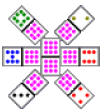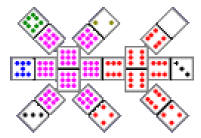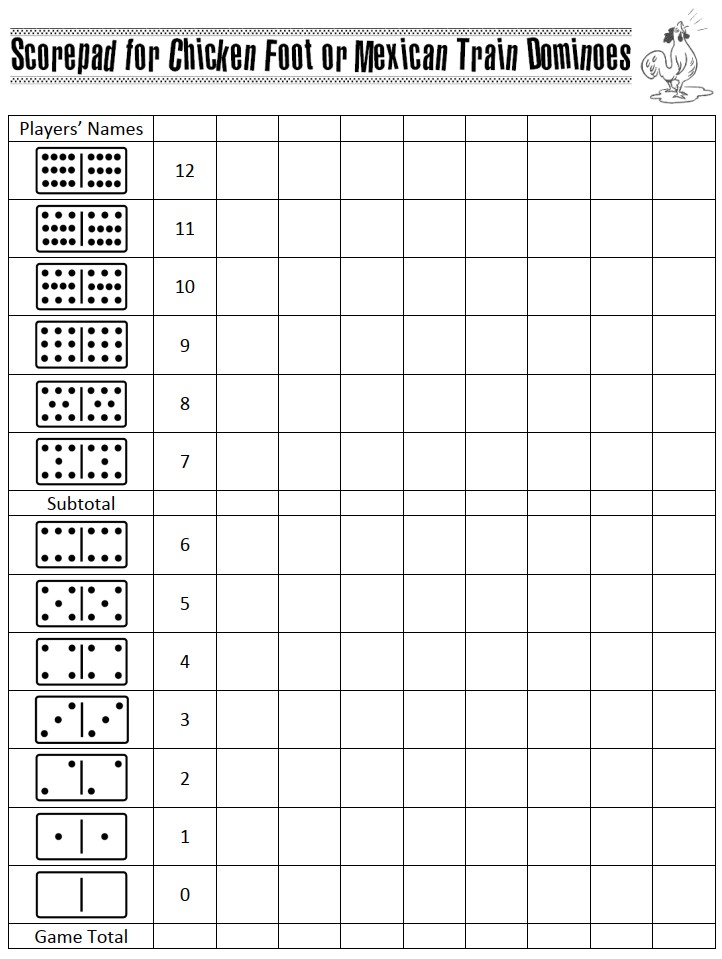
Chicken foot
Dominos Game
Jeux
Dominos

Chickenfoot is a domino game where the basic object of each hand is to get rid of all of your dominoes before your opponents can do the same. Although it is a game for 2 or more players, there are no teams; each person acts independently.
The game typically is played with Double-9 dominoes (meaning there are up to 9 spots, or pips, on the ends of each domino), while other variations include Double-6, Double-12 and Double-15.
Score is kept on a cumulative basis, as each game consists of a certain number of hands. The number of hands in a game is equal to the number of domino suits (numbers).
In other words, Double-6 dominoes have 7 suits (0-7), Double-9 dominoes have 10 suits (0-9), Double-12 dominoes have 13 suits (0-12), and Double-15 dominoes have 16 suits (0-15).
While low hand scores are important, only the cumulative score matters. The player with the lowest final score wins the game.
Initial Draw
All the dominoes are turned face-down on a smooth tabletop and mixed thoroughly. This becomes the “chicken yard.” The number of dominoes or tiles initially drawn by each player from the “chicken yard” depends on the number of players.
This is the guideline to follow to calculate the amount of tiles drawn:
42 ÷ [# of players], rounded to the nearest whole number, is the number of tiles with which each player begins the game.
| 2 Players | 3 Players | 4 Players | 5 Players | 6 Players | 7 Players | 8 Players | 9 Players | 10 Players |
| 21 Tiles | 14 Tiles | 11 Tiles | 8 Tiles | 7 Tiles | 6 Tiles | 5 Tiles | 5 Tiles | 4 Tiles |
Scoring
First and foremost, the player with the lowest final score wins the game. For
all dominoes except for the double-blank (  ), the
score associated with that domino is the number of spots, or pips, on the
domino.
), the
score associated with that domino is the number of spots, or pips, on the
domino.
For the double-blank domino, the score is 50 points. (Optionally, the double-blank domino can be scored as 25 points, but this must be decided by the players before the game begins.)
For example, in the picture, observe the remaining dominoes a player has at the end of a hand.

That player’s score for this hand is (5+5) + (1+0) + 50 + (3+1) = 65.
Without the double-blank tile, the score would have been only 15.
Object of the Game
The object of the game is to be the player with the lowest overall score. That player will win the game.
Therefore, during each hand, players should try to play their highest-scoring dominoes. For any given hand, anyone playing all of the dominoes in his/her hand will win the hand.
However, it is possible to win most of the hands but still lose the overall game. It is the cumulative number of spots, or pips, for players that determines the ultimate winner.
Rules of the Game
General Rules
Play, from person to person, moves clockwise around the table.
In the picture notice that all adjacent dominoes share a common suit (number/color). So dominoes can be played only on dominoes of like suit.

On any turn, a player does not have to play a domino; the player may draw a domino and pass without playing, if he/she so desires.
If no play can be made with the dominoes in one’s hand, that player must draw a single domino from the “chicken yard” (that is, the remaining dominoes not initially selected by players).
If the tile drawn is playable, it can (but does not have to) be played.
Otherwise, that player’s turn is over, and the next player’s turn begins.
If a player has no domino to play, but there are no dominoes left in the “chicken yard,” then that player will be forced to pass.
As mentioned previously, each game consists of a set of hands (equal to the number of domino suits or numbers). The first hand will begin with the highest double being played first.
The second hand will begin with the second-highest double, and so on. In the
case of Double-9 dominoes, the game would begin by playing the double-9 tile (
 ).
).
The second hand would begin with the double-8, the third hand with the double-7, etc.
Playing a double does not enable a player to play another domino immediately. Like any other domino, playing a double ends that player’s turn; then it is the next player’s turn to play a domino.
Whenever someone plays a double tile, that person may announce “Chickenfoot” to notify the other players that playing on that double is mandatory before any other plays can be made.
However, there is no penalty for a player who does not say “Chickenfoot” after playing a double.
Once a domino has been laid down, it is the next person’s turn to play. The domino just played may be picked up and replaced with another only if the next person has not laid down a domino.
Beginning a Hand
In a standard game, the player with the required double domino for each hand simply plays that domino to begin the hand.
If no player has the necessary double domino to start the hand, then every player must draw one domino.
This process repeats until someone draws the double domino required to begin. (Players should pay close attention to the tiles in their hands to make sure they are not overlooking the double which needs to be played.)
The next six dominoes played must be played off of the initial double domino, as shown in the picture (an example of the opening plays in a Double-9 game).

Once the six dominoes have been played off of the initial double domino (or “spinner”), play can continue off of any domino, provided the domino to be played matches the suit (number) at the end of that domino.
For each double played after the initial double, three dominoes of the same suit (number) must be played on that double before play can continue elsewhere on the board.
Alternate Beginning
There is an alternate way to begin each hand, if all of the players agree. The player with the highest available double may play it.
That is, in the case of Double-9 dominoes, if the double-9 (
 ) tile initially has not been drawn by any player,
then the double-8 (
) tile initially has not been drawn by any player,
then the double-8 (  ) tile may be played. If no
player has the double-8 tile, then the double-7 (
) tile may be played. If no
player has the double-8 tile, then the double-7 (  )
tile is played, etc.
)
tile is played, etc.
In case no player has any double tile, then every player must draw one domino. This is continued until a double is drawn.
A player announces that he/she has drawn a double, and that double is played. If multiple players draw doubles at the same time, the highest double is played.
One advantage of starting each hand with the highest available double domino is that players will not need to fill their hands with extra dominoes at the beginning of each hand, attempting to draw the required double for that particular hand on the score sheet.
If this is the chosen way to play, one thing must be kept in mind.
If any double (besides the double-9) domino is used to start the very first hand, the second hand still should begin with the double-8 tile (if any player has it), not with the double tile which is one less than the first double played in the previous hand.
On the score sheet, the preferred double to begin each hand is shown clearly at the beginning of every row.
If it is not available, the next highest double can be played.
Subsequent Doubles
Similar to the play of the initial double, every subsequent double that is played forces the next three plays to be made off of that double.
Incidentally, this is where the name of the game comes from, as the resulting configuration resembles a chicken’s foot with three claws.
The picture shows the double-6 tile added to the original round of dominoes, along with the three dominoes played on it.

As that picture indicates, the next three dominoes were played off of the double-6.
Only after the three dominoes have been played can plays again be made anywhere else on the board. A few additional plays for this same hand are shown in the picture.

Ending a Hand
Chickenlittle Rule (Optional)
It should be decided by the players, before beginning a game, whether or not the “Chickenlittle Rule” will be in effect during the game.
Whether or not the rule is used should not be changed during the game. If the “Chickenlittle Rule” is in effect, a player must say “Chickenlittle” to announce to the other players that he/she has one last domino remaining.
The player should say this as his/her next-to- last domino is being played, but at least before the next player has played. (This is very similar to the card game Uno, where players must announce that they have only one card left by calling out “Uno.”)
If a player calls “Chickenlittle,” and play continues once more around the table, then that player can lay down his/her last domino (if it can be played) and win the hand.
During a hand, if the next player manages to play a domino before “Chickenlittle” is called by a player with one tile remaining, and if the failure to call out “Chickenlittle” is pointed out by any player before play has gone once around the table, then there is a penalty for the player who forgot to call “Chickenlittle”; he/she must draw a domino without playing it.
That player may resume play when it is his/her turn again, but he/she must say “Chickenlittle,” when playing his/her next- to-last tile, so as not to be penalized again.
In case the “chicken yard” is empty, and the player who failed to say “Chickenlittle” is unable to draw, then that player is not allowed to play a domino on the subsequent round. That is, his/her turn is skipped.
However, that player must say “Chickenlittle” before the next player (to his/her left) plays; otherwise, he/she will have to skip another turn next time around.
Possible Outcomes
There are two possible outcomes for each of the hands played during the game. Either someone will win the hand, or there will be a stalemate.
Winning a Hand
If a player manages to play all of his/her dominoes, then that player wins the hand outright.
Since he/she has no remaining dominoes, a score of 0 (zero) will be recorded for that player.
All other players will score their respective hands (remaining dominoes), according to the scoring rules laid out in the Scoring section on the first page.
Stalemate
If insufficient dominoes remain to complete the mandatory play off of a double, then the hand will have reached a “stalemate” situation.
This can happen late in the hand when almost all the dominoes of a particular suit (number) have been played, and then the double of that suit is played.
If there are not three dominoes of that suit remaining, then play will continue until the rest of the dominoes of that suit have been played, and drawing will continue until the “chicken yard” has been exhausted.
Once the stalemate is final, and no player has won the hand by going out, then all players will score their respective hands (remaining dominoes).
Note:
It is possible for the hand to enter a state of “stalemate pending” but a player still win the hand.
For example, assume there are only two dominoes remaining that contain sixes after the double-6 has been played, which would be a pre-condition for a stalemate.
However, if any player manages to play a 6 as his/her last domino, then that player will win outright because he/she managed to get rid of all his/her dominoes.
Game Strategy
The most basic element of strategy, of course, is for a player to get rid of
the double-blank domino (  ), if he/she has it,
since it is worth the most (50) points.
), if he/she has it,
since it is worth the most (50) points.
Players also may want to prevent a specific player from playing the double-blank, if it is felt that this player has it.
This can be done by playing only dominoes with no blank on the open end, even though these may not be the highest-scoring dominoes in their hands.
Also, it is strategic to play a double domino when another player has a single tile left, in an attempt to force that player to draw another tile when it comes to be his/her turn.
Moreover, it is a good idea to pay attention to which doubles have not been played, as it might be a good idea to save a tile in those suits as protection from having to draw a tile later.
Other strategies can be picked up quickly by playing a few hands and observing what it takes to win a hand or to win the game.

